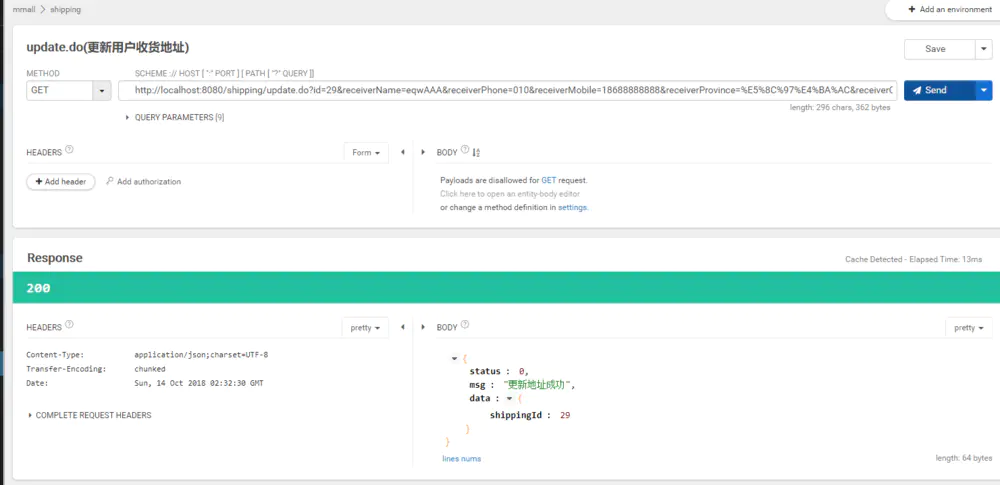收货地址管理模块
1、【收货地址管理模块】——收货地址增、删、改、查、分页列表、地址详情的功能开发
2.2
1、接口开发:
新建ShippingController类
在类上添加相关注解
@Controller
@RequestMapping("/shipping/")
public class ShippingController {
}
1、收货地址的增加:
*Controller:
//添加地址接口
@RequestMapping(value = "add.do")
@ResponseBody
public ServerResponse add(HttpSession session, Shipping shipping){
User user =(User) session.getAttribute(Const.CURRENT_USER);
if(user == null){
return ServerResponse.createByErrorCodeMessage(ResponseCode.NEED_LOGIN.getCode(),ResponseCode.NEED_LOGIN.getDesc());
}
return iShippingService.add(user.getId(), shipping);
}
*Service:
//收货地址添加方法
ServerResponse add(Integer userId, Shipping shipping);
*ServiceImpl:
//收货地址添加方法
public ServerResponse add(Integer userId, Shipping shipping){
shipping.setUserId(userId);
shipping.setCreateTime(new Date());
shipping.setUpdateTime(new Date());
int rowCount=shippingMapper.insertSelective(shipping);
if(rowCount>=0){
Map result= Maps.newHashMap();
result.put("shippingId",shipping.getId());
return ServerResponse.createBySuccess("新建地址成功",result);
}
return ServerResponse.createByErrorMessage("新建地址失败");
}
insertSelective是使用逆向工程生成的代码,所以直接调用即可。
2、收货地址删除的接口的开发:
*Controller:
//删除地址接口
@RequestMapping(value = "del.do")
@ResponseBody
public ServerResponse del(HttpSession session, Integer shippingId){
User user =(User) session.getAttribute(Const.CURRENT_USER);
if(user == null){
return ServerResponse.createByErrorCodeMessage(ResponseCode.NEED_LOGIN.getCode(),ResponseCode.NEED_LOGIN.getDesc());
}
return iShippingService.del(user.getId(), shippingId);
}
*Service:
//删除收货地址方法
ServerResponse del(Integer userId,Integer shippingId);
*ServiceImpl:
//删除收货地址方法
public ServerResponse del(Integer userId,Integer shippingId){
int rowCount=shippingMapper.deleteByShippingIdByUserId(userId,shippingId);
if(rowCount>0){
return ServerResponse.createBySuccess("删除地址成功");
}
return ServerResponse.createByErrorMessage("删除地址失败");
}
由于为了防止横向越权的问题,我们使用自己封装的deleteByShippingIdByUserId方法,在删除收货地址的时候,我们不仅判断收货地址的Id,同时还判断该收货地址是否是在当前用户下。
*Mapper:
//同时根据用户Id和地址Id来删除地址,防止横向越权
int deleteByShippingIdByUserId(@Param("userId") Integer userId, @Param("shippongId") Integer shippongId);
*Mappler.xml:
<delete id="deleteByShippingIdByUserId" parameterType="map" >
delete
from mmall_shipping
where user_id=#{userId}
and id=#{shippongId}
delete>
3、收货地址修改的接口编写:
*Controller:
//修改地址接口
@RequestMapping(value = "update.do")
@ResponseBody
public ServerResponse update(HttpSession session, Shipping shipping){
User user =(User) session.getAttribute(Const.CURRENT_USER);
if(user == null){
return ServerResponse.createByErrorCodeMessage(ResponseCode.NEED_LOGIN.getCode(),ResponseCode.NEED_LOGIN.getDesc());
}
return iShippingService.update(user.getId(), shipping);
}
*Service:
//修改地址接口
ServerResponse update(Integer userId,Shipping shipping);
*ServiceImpl:
//修改地址方法
public ServerResponse update(Integer userId,Shipping shipping){
shipping.setUserId(userId);
Shipping selship=shippingMapper.selectByShippingIdByUserId(userId,shipping.getId());
if(selship == null){
return ServerResponse.createByErrorMessage("该用户不存在此地址");
}else {
int rowCount= shippingMapper.updateByshipping(shipping);
if(rowCount>=0){
Map result= Maps.newHashMap();
result.put("shippingId",shipping.getId());
return ServerResponse.createBySuccess("更新地址成功",result);
}
}
return ServerResponse.createByErrorMessage("更新地址失败");
}
updateByshipping方法:
*Mapper:
//修改地址接口
int updateByshipping(Shipping record);
*Mappler.xml:
<update id="updateByshipping" parameterType="com.mmall.pojo.Shipping">
update mmall_shipping
set receiver_name = #{receiverName,jdbcType=VARCHAR},
receiver_phone = #{receiverPhone,jdbcType=VARCHAR},
receiver_mobile = #{receiverMobile,jdbcType=VARCHAR},
receiver_province = #{receiverProvince,jdbcType=VARCHAR},
receiver_city = #{receiverCity,jdbcType=VARCHAR},
receiver_district = #{receiverDistrict,jdbcType=VARCHAR},
receiver_address = #{receiverAddress,jdbcType=VARCHAR},
receiver_zip = #{receiverZip,jdbcType=VARCHAR},
create_time = #{createTime,jdbcType=TIMESTAMP},
update_time = now()
where id = #{id,jdbcType=INTEGER}
and user_id = #{userId,jdbcType=INTEGER}
update>
4、查询地址接口:
*Controller:
//查询地址接口
@RequestMapping(value = "select.do")
@ResponseBody
public ServerResponse select(HttpSession session, Integer shippingId){
User user =(User) session.getAttribute(Const.CURRENT_USER);
if(user == null){
return ServerResponse.createByErrorCodeMessage(ResponseCode.NEED_LOGIN.getCode(),ResponseCode.NEED_LOGIN.getDesc());
}
return iShippingService.select(user.getId(), shippingId);
}
*Service:
//查询收货地址的方法
ServerResponse select(Integer userId,Integer shippingId) ;
*ServiceImpl:
//查询收货地址的方法
public ServerResponse select(Integer userId,Integer shippingId) {
Shipping shipping=shippingMapper.selectByShippingIdByUserId(userId,shippingId);
if(shipping == null){
return ServerResponse.createByErrorMessage("无法查询到该地址");
}
return ServerResponse.createBySuccess("查询地址成功",shipping);
}
*Mapper:
```//查询收货地址接口
Shipping selectByShippingIdByUserId(@Param("userId") Integer userId, @Param("shippongId") Integer shippongId);
*Mappler.xml:
<select id="selectByShippingIdByUserId" resultMap="BaseResultMap" parameterType="map" >
select
<include refid="Base_Column_List"/>
from mmall_shipping
where id= #{shippongId}
and user_id=#{userId}
select>
5、查询所有地址接口开发(带分页):
*Controller:
//查询所有地址接口(带分页)
@RequestMapping(value = "list.do")
@ResponseBody
public ServerResponse list(@RequestParam(value = "pageNum",defaultValue = "1") int pageNum, @RequestParam(value = "pageSize",defaultValue = "10") int pageSize, HttpSession session) {
User user =(User) session.getAttribute(Const.CURRENT_USER);
if(user == null){
return ServerResponse.createByErrorCodeMessage(ResponseCode.NEED_LOGIN.getCode(),ResponseCode.NEED_LOGIN.getDesc());
}
return iShippingService.list(user.getId(),pageNum,pageSize);
}
*Service:
//查询所有收货地址的方法
ServerResponse list(Integer userId, int pageNum, int pageSize) ;
*ServiceImpl:
//查询所有收货地址的方法
public ServerResponse list(Integer userId,int pageNum, int pageSize) {
PageHelper.startPage(pageNum,pageSize);
List shippingList=shippingMapper.selectByUserId(userId);
PageInfo pageInfo= new PageInfo(shippingList);
return ServerResponse.createBySuccess(pageInfo);
}
*Mapper:
//查询所有收获地址接口
List selectByUserId(Integer userId) ;
*Mappler.xml:
<select id="selectByUserId" resultMap="BaseResultMap" parameterType="map">
select
<include refid="Base_Column_List"/>
from mmall_shipping
where user_id=#{userId}
select>
2、接口测试:
1、收货地址接口测试
2、收货地址删除的接口测试
3、收货地址修改的接口测试
4、查询地址接口测试
5、查询所有地址接口测试






